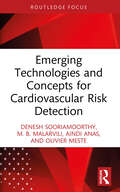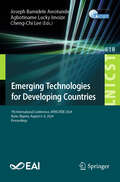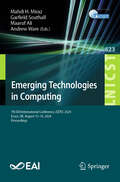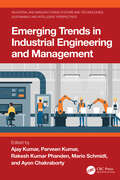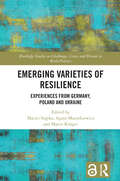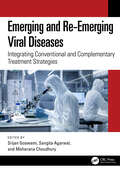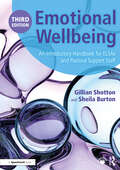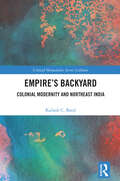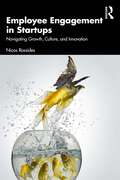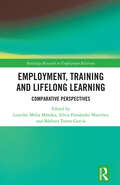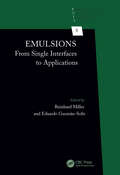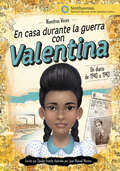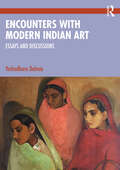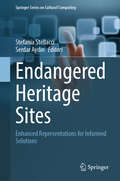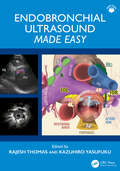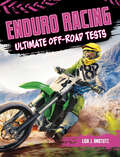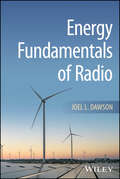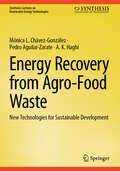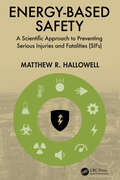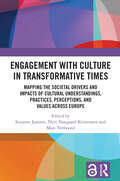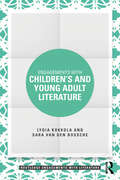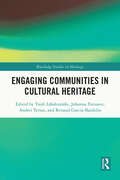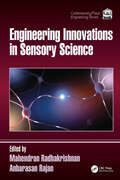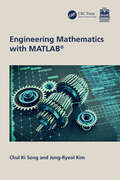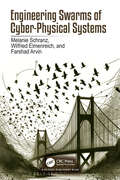- Table View
- List View
Emerging Technologies and Concepts for Cardiovascular Risk Detection
by Denesh Sooriamoorthy M. B. Malarvili Aindi Anas Olivier MesteThis accessible guide to advanced medical technologies and methodologies for monitoring, diagnosing, and predicting cardiovascular diseases addresses sensor technologies and non-invasive monitoring methods and looks at the growing integration of machine learning and AI.The authors guide readers from an introduction to the cardiovascular system and a review of traditional and modern diagnostic methods before explaining recent advances in medical technology, such as wearable smart devices and their sensor types (namely, pressure, photoelectric, and ultrasonic), and how these advances have been applied to cardiovascular disease diagnosis and detection. Key topics include pulse wave analysis, sensor technology for radial blood pressure monitoring, and the integration of artificial intelligence to enhance predictive accuracy. With a focus on continuous monitoring solutions, this book highlights groundbreaking research on non-invasive detection methods and the development of intelligent health systems for real-time patient evaluation. The authors also discuss how the widespread implementation of machine learning and deep learning techniques have influenced the field and propose new methods for enhancing continuous monitoring and risk prediction systems. The information within this book will help to bridge the gap between research and clinical practice.This short guide is a valuable resource primarily for academic readers in the fields of biomedical engineering, physics, computer science, and medical imaging. Clinicians will also benefit from the discussions of applications and future research and clinical trends.
Emerging Technologies for Developing Countries: 7th International Conference, AFRICATEK 2024, Ilorin, Nigeria, August 6–8, 2024, Proceedings (Lecture Notes of the Institute for Computer Sciences, Social Informatics and Telecommunications Engineering #618)
by Agbotiname Lucky Imoize Cheng-Chi Lee Joseph Bamidele AwotundeThis book constitutes the refereed conference proceedings of the 7th International Conference on Emerging Technologies for Developing Countries, AFRICATEK 2024, held in Ilorin, Nigeria, during August 6–8, 2024. The 15 full papers included in this book were carefully reviewed and selected from 42 submissions. They were organized in the below following topics such as : Smart, Sustainable Cities and Climate Change Management; Innovation in Healthcare Systems; Environmental Monitoring, Smart Agriculture and Smart Education.
Emerging Technologies in Computing: 7th EAI International Conference, iCETiC 2024, Essex, UK, August 15–16, 2024, Proceedings (Lecture Notes of the Institute for Computer Sciences, Social Informatics and Telecommunications Engineering #623)
by Andrew Ware Mahdi H. Miraz Maaruf Ali Garfield SouthallThis book LNICST 623 constitutes the refereed conference proceedings of the 7th International Conference on Emerging Technologies in Computing, iCETiC 2024, held in Essex, UK, during August 15–16, 2024. The 17 full papers were carefully reviewed and selected from 58 submissions. The proceedings focus on topics such as 1) AI, Expert Systems and Big Data Analytics 2) Cloud, IoT and Distributed Computing
Emerging Trends in Industrial Engineering and Management (Industrial and Manufacturing Systems and Technologies: Sustainable and Intelligent Perspectives)
by Ajay Kumar, Parveen Kumar, Rakesh Kumar Phanden, Mario Schmidt, and Ayon ChakrabortyEmerging trends in Industrial Engineering and Management (IEM) refer to the new and transformative developments, practices, and technologies that are currently gaining prominence in the field of industrial engineering and management. Trends in Industrial Engineering and Management can encompasses a wide range of topics such as utilization of Industry 4.0 strategies like Industrial Internet of Things, artificial Intelligence, theoretical, numerical, computational approaches to model the methods and process of IEM.This book: Provides a comprehensive discussion of industrial engineering and management Includes principles of continuous improvement, encouraging readers to adopt a mind-set of on-going optimization and innovation in industrial engineering and management Presents multi-objective optimization, stochastic optimization, and metaheuristic optimization algorithms for solving complex optimization problems in industrial engineering Aligns with the needs of various industries, addressing specific challenges faced by manufacturing, healthcare, logistics, service, and other sectors Highlights the importance of using digital technological tools like the Internet of Things, Industrial Internet of Things, big data, and artificial intelligence in practices of industrial management to enhance competitiveness, decision-making, and operations efficiency It is primarily written for senior undergraduates, graduate students, and academic researchers in the fields of industrial engineering, production engineering, mechanical engineering, operation management, industrial management, quality engineering, and engineering management.
Emerging Varieties of Resilience: Experiences from Germany, Poland and Ukraine (Routledge Studies on Challenges, Crises and Dissent in World Politics)
by Marco Krüger Maciej Stępka Agata MazurkiewiczThis book focuses on developments of resilience in Europe, discussing its different interpretations and enactments, as well as approaches to national security and crisis and disaster management.Examining war-time resilience, increased refugee flows into the EU, societal resilience, and its general application of the concept in national security strategies, the book juxtaposes the multifaceted nature of resilience in different, yet connected, European countries. In doing so, it illuminates the multiplicity of approaches and interpretations that allows a deeper understanding of dynamically (re)developing approaches to resilience.This book will be of key interest to scholars, students, and practitioners working in crisis response, disaster management, and resilience and more broadly to European studies, migration studies, security studies, politics, public policy, and international relations.Chapter 4 and Chapter 6 of this book are freely available as a downloadable Open Access PDFs at http://www.taylorfrancis.com under a Creative Commons Attribution-Non Commercial-No Derivatives (CC-BY-NC-ND) 4.0 license.
Emerging and Re-Emerging Viral Diseases: Integrating Conventional and Complementary Treatment Strategies
by Srijan Goswami Moharana Choudhury Sangita AgarwalThis reference book offers an in-depth analysis of the fundamental aspects, causative agents, and clinical manifestations of emerging and re-emerging infectious diseases of viral origin (EID-REID). It elucidates the role of evolutionary processes in the emergence, adaptation, and dissemination of pathogens. The initial chapter explores the causative agents behind EID-REID, providing a comprehensive overview of their origins, characteristics, and modes of transmission. The book further presents the structure, pathophysiology, and clinical presentation of various viral pathogens, including notable viruses such as the Crimean-Congo hemorrhagic fever Orthonairovirus (CCHFV), Rift Valley fever virus, Lassa virus, Nipah virus (NiV), Filoviridae, and coronaviruses (MERS, SARS, SARS-CoV-2). Additionally, the book elucidates the multifaceted landscape of treatment strategies, highlighting the pivotal role of pharmacological strategies, investigational drugs, vaccines, and immunomodulatory approaches. It also underscores the importance of clinical examination, immunoassays, and molecular diagnostic techniques for the early detection and accurate diagnosis of viral EID-REID. Toward the end, the book sheds light on the pivotal role of the Ayurveda, homoeopathic system of medicine, medical nutrition therapy, computational biology, bioinformatics, and systems biology in advancing disease management paradigms. This book is intended for epidemiologists, virologists, infectious disease specialists, and other healthcare practitioners who seek in-depth knowledge about emerging and re-emerging infectious diseases.
Emotional Wellbeing: An Introductory Handbook for ELSAs and Pastoral Support Staff
by Gillian Shotton Sheila BurtonThis is an essential resource for educators working to support emotional wellbeing in children and young people. Written by the team behind the Emotional Literacy Support Assistant (ELSA) training programme, it provides practical suggestions that can be implemented straight away to make a positive difference in the life of the young person.Fully updated, the third edition of this bestselling guide includes a new chapter on trauma and adverse childhood experiences, as well as expanded material to support neurodivergent children, help those who struggle with worry, and work more closely with parents and carers. The chapters give a clear overview of each topic underpinned by the latest research in educational psychology, descriptions of vulnerabilities as well as case studies, 'let's get practical' ideas, and reflective moments. Topics include: Self-esteem Friendship skills Social skills Therapeutic stories Understanding anger and anxiety Dealing with loss and bereavement. With fresh colour illustrations throughout, this resource will be vital reading for ELSA trainees as well as anyone wanting to provide the best possible support for the emotional wellbeing of the young people they work with. It is designed for use with individuals, groups or whole classes.
Empire’s Backyard: Colonial Modernity and Northeast India (Critical Humanities Across Cultures)
by Kailash BaralThis book transcends traditional historical analysis to explore the intricate tapestry of colonialism, modernity, and identity formation in Northeast India. Moving beyond a simplistic view of the region as the British Empire’s ‘backyard,’ it examines the transformative processes that turned Northeast India beyond Sylhet, the empire’s eastern outpost, into a vibrant frontier. While recognizing the importance of exploration and territorial expansion in establishing colonial dominance, the narrative emphasizes the crucial roles of resistance and local agency in shaping the region’s history.The volume critically analyzes the influence of the Church as a powerful force within the ‘civilizing mission,’ alongside military interventions. It dissects the complex relationship between colonialism and modernity, revealing how the rhetoric of progress often concealed motives of resource extraction and cultural disruption. Through a meticulous unraveling of structures, systems, and processes, the work weaves a compelling narrative of Northeast India, not as a passive recipient of colonial ideas, its imposition of alien rules and values but as a region actively shaped by the interplay of power, resistance, and adaptation.This book will be of interest to scholars, researchers, and students of history, sociology, colonial and postcolonial studies, cultural studies, and South Asian studies, especially those concerned with Northeast India.
Employee Engagement in Startups: Navigating Growth, Culture, and Innovation
by Nicos RossidesThe relentless pace, the challenge of the untried, the dive into the unknown—this is the startup world. It converges with the deep human needs for mastery, growth, and meaning.This book explores that crucial intersection. Unlike other books on employee engagement, this one is written specifically for the startup environment. It combines lessons learned from years leading businesses, direct experience with innovative startups, and insights from the latest research on both engagement and entrepreneurship. Discover clear, workable strategies to navigate keeping your team engaged throughout your startup's journey.This book is a vital resource for students, academics, and professionals alike who need proven ways to build connected, high-performing startup teams.
Employment, Training and Lifelong Learning: Comparative Perspectives (Routledge Research in Employment Relations)
by Lourdes Mella Méndez Silvia Fernández Martínez Bárbara Torres GarcíaThis book offers a timely exploration of the continuous training of individuals, a subject crucial to both business competitiveness and societal progress in today’s rapidly changing world. Addressing the digital and climate revolutions, it examines how lifelong learning helps workers adapt their skills to meet evolving demands while supporting active ageing for all citizens, even in retirement.Divided into three sections, the book features studies that combine theoretical insights and practical recommendations from renowned experts in education and law. The book stands out for its international scope, with chapters covering diverse national perspectives from countries such as the United Kingdom, the United States, Japan and various European nations. It uniquely integrates both education and legal perspectives, providing a comprehensive analysis that addresses gaps in existing literature. Readers will benefit from clear, accessible language, proposals for key stakeholders (e.g., policymakers, social partners), and coverage of pressing issues like vocational training for immigrants, legal frameworks for non-formal learning and the impact of digital transitions on workforce development.This book is an essential resource for academics, researchers, advanced students, legal professionals, educators, policymakers, trade unions, and employer associations. It offers valuable insights for anyone involved in Labour Law, social security, vocational training or workforce development on a global scale.
Emulsions: From Single Interfaces to Applications (Progress in Colloid and Interface Science)
by Reinhard Miller and Eduardo Guzmán-SolísThis book presents a comprehensive investigation of the complex scientific principles and practical applications of emulsions, offering valuable references for researchers, industry professionals, and advanced students in the fields of physical chemistry, material sciences, and engineering. The book is structured in three sections, which allow the readers to explore the fundamental principles of interfacial phenomena, the methodologies for emulsion preparation, and the diverse applications of emulsions in various industrial branches in depth.The initial section establishes the fundamental principles, with a particular focus on the physico-chemical characterization of interfaces pertinent to emulsion stabilization. The book meticulously examines several topics, including adsorption dynamics, particle-laden interfaces and thin liquid films. It supports these discussions with a combination of experimental techniques and theoretical insights. The second section shifts focus to the practical aspects of emulsion production, examining state-of-the-art methods, the role of stabilizers, and strategies for enhancing their stability, including innovations in nanoemulsions and aqueous two-phase systems. The final section presents several real-world applications, demonstrating the significant role that emulsions play in a number of fields, including the petroleum industry, pest control and pharmaceutical formulations.This text, featuring contributions from leading experts, synthesizes foundational knowledge and cutting-edge research, thereby bridging the gap between theory and practice. With an interdisciplinary scope, the book addresses both academic and industrial perspectives, and is therefore an indispensable addition to the library of anyone working with emulsions. It provides the tools and understanding required to advance work in the development of new materials, optimization of formulations, and investigation of the mechanics of interfacial systems.
En casa durante la guerra con Valentina: un diario de 1940 a 1943 (Nuestras Voces)
by Claudia OviedoEn 1940, Valentina, de once años, asume nuevas responsabilidades cuando sus hermanos mayores se alistan en la Guardia Nacional en vísperas de la entrada de Estados Unidos en la Segunda Guerra Mundial, a la vez que lidia con el rechazo a su familia mexicano-estadounidense por parte de la comunidad de Texas. In 1940, eleven-year-old Valentina takes on new responsibilities as her older brothers join the National Guard in the lead-up to the United States' entry into World War II, while also grappling with the lack of acceptance her Mexican American family experiences in their Texas community.
Encounters with Modern Indian Art: Essays and Discussions
by Yashodhara DalmiaThis book explores modern art in India, tracing its evolution from the setting-up of the Progressive Artists Group in the 1940s to the contemporary movements today. It discusses some of the fundamental issues around Indian art, such as the extent of its rootedness in the country, the amalgamation of Western art methods and Indian aesthetics in the art and its increasing infusion with popular modes.In a series of essays, the book looks at works from the late Mughal period, when artists began to move towards modernism, to the visionary approaches of artists like Rabindranath Tagore, Nandalal Bose, Ramkinkar Baij and Benodebehari Mukherjee in Santiniketan. It also explores innovative works of the Indo-Hungarian artist Amrita Sher-Gil and contributions of progressive artists such as Francis Newton Souza, Sayed Haider Raza and M.F. Husain to the new and experimental forms being practised in the present, highlighting the transformative role of modern Indian art through the twentieth century as the works of each successive generation reflect the socio-cultural contexts.With rich illustrations, the book will be of interest to students and educators of art, art history, intellectual and cultural history, as well as to connoisseurs of art.
Endangered Heritage Sites: Enhanced Representations for Informed Solutions (Springer Series on Cultural Computing)
by Stefania Stellacci Serdar AydinThis book provides a thorough exploration of how heritage representation has evolved in the digital age, highlighting connections between diverse informed solutions for preserving and interpreting heritage knowledge. It provides a holistic overview of advanced surveying and visualization tools essential for decoding and analyzing cultural heritage data. Techniques such as remote sensing, heritage building information modeling (HBIM), knowledge graphs, and game-based learning can unveil the complex layers inherent in endangered heritage sites. Beyond these tools, the book examines policy perspectives that require critical review and collective efforts. A key focus of the contributions is the revolutionary role of the smart heritage information base as a new form of knowledge and practice. Enriched representations and integrated analyses have revolutionized heritage practices, moving beyond the traditional eidotypes that were prevalent until the first decade of the 21st century. The diverse array of the collected contributions in this book highlights a cultural and technical shift that represents a significant methodological and epistemological progress in the fields of digital humanities and heritage management. With insightful analyses of heritage sites, especially archaeological remains, through real-world case studies in Spain, Portugal, Turkey, Pakistan, and Israel, this book delves into the challenges posed by human-made induced disasters and natural hazards, offering valuable insights into safeguarding our cultural heritage. These case studies not only show the challenges local sites and communities face now and, in the future, but also enrich the discourse on how to protect our shared cultural heritage together. The advanced mapping and analysis of these case studies reveal the importance to unveil hidden narratives, protect collective values, and reshape perspectives on cultural heritage in the digital age. The target audience includes heritage practitioners, architects, archaeologists, urban planners, data scientists, researchers, academics, teaching institutions, and architecture students. Its international scope is reflected in contributions and editors from diverse locations. The thematic breadth appeals to a global readership interested in different theoretical and methodological approaches, complemented by a range of case studies across different cultural, economic, and environmental contexts and future scenarios.
Endobronchial Ultrasound Made Easy
by Kazuhiro Yasufuku Rajesh ThomasThis is a concise, yet comprehensive book that teaches all essential aspects of the practice of Endobronchial Ultrasound (EBUS) bronchoscopy. Written by world experts, who share their clinical experience to provide a practical and step-by-step approach to learning and performing linear and radial EBUS bronchoscopy. Supplemented by more than 250+ high-quality illustrations, images and videos selected from the authors’ personal collections, all chapters include expert tips, clinical pearls, rare cases and interactive self-assessment sections to enhance and reinforce the learning of both beginner and advanced bronchoscopists wishing to learn, practice and teach EBUS.Key Features: Features rare and interesting EBUS cases followed by Multiple Choice Questions in each chapter Explores the subject through a wealth of accompanying illustrations and teaching videos for a fun learning experience for bronchoscopists, fellows and trainees in respiratory medicine, oncologists and thoracic surgeons who perform EBUS Fills a spot in the market for a quick reference which has updated, practical information from international experts in the field of EBUS with a strong visual component which is especially key for this diagnostic modality.
Enduro Racing
by Lisa AmstutzA dirt bike rider twists the throttle. He zooms down a steep hill and leans the bike around a corner. The rider has finished the enduro test. Now it’s onto the next one! Enduro riders are scored as they zip through test sections on off-road trails. Mile after mile, these brave riders give their all for the win. Put readers in the center of the exciting enduro action as they learn about everything from race rules to course features and equipment. Carefully leveled, high-energy text helps ensure accessibility for even the most reluctant readers.
Energy Fundamentals of Radio
by Joel L. DawsonUnderstand the technology that has reshaped global communication. Wireless communication has transformed virtually every area of global technology, interaction, and commerce. The flow of information between transmitter and receiver without the aid of wires or cables has placed online and network communication on a revolutionary new footing, with ramifications that are still being felt. No communications or information professional can be without a working knowledge of this area of technology. Energy Fundamentals of Radio provides an accessible, readable overview of this critical subject. It emphasizes the fundamental realities of wireless communication with respect to energy use and energy tradeoffs, surveys the major theories underlying wireless technology, and analyzes key 5G techniques that can minimize energy consumption. The result promises to be a standard introduction to the field. Energy Fundamentals of Radio readers will also find: Detailed discussion of topics including antenna theory, electromagnetic fields, sustainability, and more. In-depth chapter on The Shannon Limit to demonstrate a key principle in the field. Energy Fundamentals of Radio is ideal for any communications, networking, or information professional looking for a one-stop reference on wireless technology.
Energy Recovery from Agro-Food Waste: New Technologies for Sustainable Development (Synthesis Lectures on Renewable Energy Technologies)
by A. K. Haghi Mónica L. Chávez-González Pedro Aguilar-ZarateAs is well known, fossil fuels and food waste are significant contributors to the climate change crisis. Conversion of food waste to energy can help solving or mitigating these problems by providing a sustainable energy alternative to fossil fuels. This book provides an overview of technologies to convert food waste to energy. It explains the rationale behind this approach and describes different methods of turning food waste into energy, factors affecting the productivity of these processes, and the advantages and challenges of these technologies. Current research in the field and selected case studies are also described.
Energy-Based Safety: A Scientific Approach to Preventing Serious Injuries and Fatalities (SIFs)
by Matthew R. HallowellDespite steady improvements in reducing minor injuries over the past two decades, the rate of serious injuries and fatalities (SIFs) has remained stubbornly flat. Research has revealed that the hazards causing minor injuries are not the same as those leading to fatalities, making traditional safety approaches insufficient. Energy-Based Safety (EBS) presents a science-backed strategy for SIF prevention, built on four core principles that emphasize the role of hazardous energy, the power of effective controls, and the critical influence of workers in shaping safety outcomes.This book is a useful resource for those committed to saving lives and delivering change in workplace safety through new ways of injury prevention. Divided into two parts, it firstly explores the research behind EBS and investigates each principle with evidence, case studies, and practical insights from real-world implementation. The second part focuses on incorporating EBS into existing safety practices, from design and work planning to incident learning and performance measurement.Through reading this book, readers will gain practical tools and methods to enhance safety programs, making SIF prevention effective and sustainable in their workplace. Written for safety professionals, Energy-Based Safety: A Scientific Approach to Preventing Serious Injuries and Fatalities (SIFs) is an enlightening read for industry leaders in occupational health and safety and practitioners responsible for workplace safety and occupational risk.
Engagement with Culture in Transformative Times: Mapping the Societal Drivers and Impacts of Cultural Understandings, Practices, Perceptions, and Values across Europe
by Nete Nørgaard Kristensen Susanne Janssen Marc VerboordAt the heart of this volume are the questions: What does culture mean to European citizens in the face of globalisation, digitalisation, diversity, and social inequality? How do Europeans engage with culture in its various forms, and what societal values are tied to this cultural engagement? These questions are explored in depth across the 15 chapters of this book. By delving into the understandings, practices, perceptions, affordances, and impacts of culture, this book advances the study of the societal values of culture in contemporary European societies, offering insights beneficial to both research and cultural policy work.The book stands out with its five unique features. It embraces an inclusive conception of culture, spanning the arts, popular culture, and everyday cultural practices, both offline and online. It takes a grassroots approach, starting from the cultural understandings and experiences of European citizens. It employs a comparative method involving people from diverse socio-economic groups in nine European countries – with different cultural policy models, social-structural features, socio-cultural value orientations, and media systems. It builds on a multi- and mixed-methods approach, including a large-scale survey, a smartphone study with experimental stimuli, several phases of online content data collection and analysis, qualitative interviews, and focus groups. Finally, it delves into how wide-ranging and interconnected sociocultural transformations such as migration, digitalisation, and social inequality impact people’s understanding of and engagement with culture as well as the meanings and values they attribute to culture. These unique features promise to offer a fresh and comprehensive perspective on cultural engagement in contemporary European societies.The collection showcases the multiple, often contradictory concepts and understandings of culture and its societal values among social groups within and across European societies. The findings call for a “social turn” in cultural policy that extends beyond traditional arts and culture to support diverse cultural expressions that may enhance social values, address complex social issues, and shift the focus from economic objectives to promoting civic solidarity, equity, inclusivity, tolerance, and shared community values.
Engagements with Children’s and Young Adult Literature (Routledge Engagements with Literature)
by Lydia Kokkola Sara Van den BosscheEngagements with Children’s and Young Adult Literature offers an accessible guide to studying Children’s and Young Adult (CYA) literature, teaching readers how to read critically. This book introduces this dynamic field encompassing diverse genres, audiences, and interpretations. Lydia Kokkola and Sara Van den Bossche examine its historical, cultural, and ideological dimensions while addressing adult perspectives and the ambivalence of child agency. Tools for critical analysis, genre-specific insights, and emerging research trends enhance readers’ engagement with CYA literature and its broader implications.The book approaches CYA literature from various complementary angles: Historical: the influence of religious and philosophical convictions on its development; Thematic: commonly-occurring genres and types of CYA literature, such as realism versus speculative fiction; Narratological: plot, time, tension, character, and setting; Visual: the main principles for 'reading' images in picturebooks, graphic novels, and comics; Ideological: power dynamics and common constructions of childhood; Social: questions of identity politics related to race, gender, and orientation, and offers tools to read critically. Engagements with Children’s and Young Adult Literature brings together established theories and new perspectives on CYA literature, combining engagement with theory with hands-on analytical, interpretive, and methodological tools for budding scholars of CYA literature. Exploring a diverse range of writing, this dynamic introduction is an invaluable resource for students and scholars of this vibrant field.
Engaging Communities in Cultural Heritage (Routledge Studies in Heritage)
by Tuuli Lähdesmäki Andrei Terian Johanna Turunen Renaud Garcia-BardidiaThis book explores the concepts and practices of participation and community engagement in cultural heritage, examining the impact of the participatory turn in the heritage sector and the key opportunities and challenges it presents.Participation has become a widely used umbrella term in the discourses of heritage institutions, practitioners, and scholars alike. This participatory turn represents a shift towards the active involvement of communities, stakeholders, and the public in decision-making processes, moving away from traditional top-down approaches towards more inclusive and collaborative models in which diverse voices contribute to cultural heritage. While the pluralisation of heritage narratives, meanings, and practices can sometimes give rise to societal tensions, this book argues that broader participation is essential for unlocking heritage’s transformative potential and future-oriented impetus. The book explores these issues through 15 case studies drawn from across the globe and organised into three thematic sections: social inclusion in heritage practices, the role of digital tools in heritage participation, and participatory heritage management and governance. These case studies contribute to emerging debates on expanding the spaces where heritage participation and community engagement take place.Interdisciplinary in nature, this book is intended for scholars and professionals working on cultural heritage, participation, social inclusion, digitisation, management, and community and audience engagement. It is also well-suited for undergraduate and graduate courses that critically examine heritage participation and community engagement in today’s pluralistic societies.
Engineering Innovations in Sensory Science (Contemporary Food Engineering)
by Mahendran Radhakrishnan Anbarasan RajanSensory analysis is significant in food product development, and its importance impacts the maintenance of sensory qualities for food products. While there are many books exploring sensory analysis and its methods, this is the first of its kind to also explore the use of engineering tools and instruments to produce measurable and reliable data. In exploring sensory analysis methods, this book also focuses on the novel computer interface technologies to retrieve human sensory perceptions directly from the human body and convert them into a measurable unit, exploring the present status in computer interface technologies and scope for interventions to overcome obstacles.Mahendran Radhakrishnan attained his PhD in Food Process Engineering from Tamil Nadu Agricultural University, India. Prior to this, he received degrees in Industrial Biotechnology as well as Chemical Engineering. He is presently Professor and Head of Department of Food Process Technology at National Institute of Food Technology, Entrepreneurship and Management, Thanjavur (NIFTEM-T). Dr. Mahendran’s research focus includes Advances in Food Processing Technologies, novel non-thermal processing, including Cold Plasma, High Pressure Processing Applications in Agri-Food, Food Structure & Shape Transformation (4D Printing), and Super Critical CO2 Extraction. Mahendran has authored over 150 publications in reputed journals.Anbarasan Rajan is Food Process Engineer who earned his M.Tech and Ph.D. in Food Process Engineering from the National Institute of Food Technology, Entrepreneurship and Management, Thanjavur (NIFTEM-T). His primary research areas include nonthermal food processing, 4D foods/food shape morphing, and sensory science.
Engineering Mathematics with MATLAB
by Chul Ki Song Jong-Ryeol KimThis textbook takes a streamlined, practical approach, designed to make engineering mathematics accessible and manageable for undergraduate students and instructors alike. Students will gain a fundamental understanding within the scope of a two-semester course.This textbook introduces students to the fundamental principles of engineering mathematics through concise explanations, systematically guiding them from the basics of first-order, second-order, and higher-order ordinary differential equations (ODEs), Laplace transforms, and series solutions of ODEs. It then transitions to more advanced topics, including linear algebra, linear system of ODEs, vector differential calculus and vector integral calculus, Fourier analysis, partial differential equations (PDEs), and concludes with complex numbers, complex functions, and complex integration. The book presents fundamental principles systematically with concise explanations. It features categorized key concepts, detailed solutions, and alternative methods to connect material to prior knowledge. Exercises are thoughtfully organized, balancing problem-solving practice with real-world applications in fields like mechanical engineering, electrical engineering, chemical engineering, and so on. Notably, this book incorporates MATLAB® to enhance understanding. MATLAB-based examples simplify complex calculations, offering visualizations that connect theory and practice. Chapters also include optional advanced topics, providing deeper insights for motivated learners.Designed with practicality in mind, this book offers a balanced approach to mastering engineering mathematics, with a manageable workload aligned to academic schedules. It is an invaluable resource for instructors seeking effective teaching tools and for students aiming to build strong mathematical foundations that they can apply to their own engineering discipline.
Engineering Swarms of Cyber-Physical Systems
by Wilfried Elmenreich Farshad Arvin Melanie SchranzEngineering Swarms for Cyber-Physical Systems covers the whole design cycle for applying swarm intelligence in Cyber-Physical Systems (CPS) and guides readers through modeling, design, simulation, and final deployment of swarm systems. The book provides a one-stop-shop covering all relevant aspects for engineering swarm systems. Following a concise introduction part on swarm intelligence and the potential of swarm systems, the book explains modeling methods for swarm systems embodied in the interplay of physical swarm agents. Examples from several domains including robotics, manufacturing, and search and rescue applications are given. In addition, swarm robotics is further covered by an analysis of available platforms, computation models and applications. It also treats design methods for cyber-physical swarm applications including swarm modeling approaches for CPSs and classical implementations of behaviors as well as approaches based on machine-learning. A chapter on simulation covers simulation requirements and addresses the dichotomy between abstract and detailed physical simulation models. A special feature of the chapters is the hands-on character by providing programming examples with the different engineering aspects whenever possible, thus allowing for fast translation of concepts to actual implementation. Overall, the book is meant to give a creative researcher or engineer the inspiration, theoretical background, and practical knowledge to build swarm systems of CPSs. It also serves as a text for students in science and engineering.
